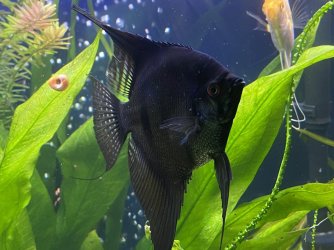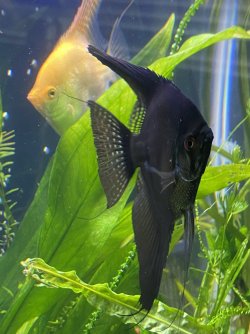Hole in the head disease and head and lateral line disease are caused by Hexamita, which is a parasite that loves dirty tank conditions. It has nothing to do with soft water, carbon or anything else.
Hole in the head and head and lateral line disease are caused by excess nutrients in the water, not lack of nutrients.
It usually starts out as small white pimple type lumps around the head and face. These grow for a few days and start to look like small white worms coming out of the fish's head. Then the white bits disappear and the fish is left with a crater/ pit in the head. These pits continue to grow and more appear as the disease progresses. You can use Metronidazole or salt to cure it but you need to treat the tank and fish for 1-2 weeks (normally 1 week for metronidazole and 2 weeks for salt). And you need to keep the tank clean to stop the disease coming back. If you just treat the fish in a quarantine tank and then put it back in the main tank, the disease is still in the main tank and simply re-infects the fish. Fish that have been infected and successfully treated will usually have scars from the pits that remain for the rest of the fish's life.
The inflammation in the mouth is probably related to the disease and to poor water quality (dirty environment).
Directions for using salt are below. Salt is safer for the environment than Metronidazole, which is an antibiotic designed for people.
-----------------------
WATER CHANGES
I would do a bigger water change each week. You want to do at least 50% and preferably 75% each week.
Make sure any new water is free of chlorine/ chloramine before it's added to the tank.
You do water changes for 2 main reasons.
1) to reduce nutrients like ammonia, nitrite & nitrate.
2) to dilute disease organisms in the water.
Fish live in a soup of microscopic organisms including bacteria, fungus, viruses, protozoans, worms, flukes and various other things that make your skin crawl. Doing a big water change and gravel cleaning the substrate on a regular basis will dilute these organisms and reduce their numbers in the water, thus making it a safer and healthier environment for the fish.
If you do a 25% water change each week you leave behind 75% of the bad stuff in the water.
If you do a 50% water change each week you leave behind 50% of the bad stuff in the water.
If you do a 75% water change each week you leave behind 25% of the bad stuff in the water.
-----------------------
GH, KH & pH
What is the GH (general hardness), KH (carbonate hardness) and pH of your water supply?
This information can usually be obtained from your water supply company's website or by telephoning them. If they can't help you, take a glass full of tap water to the local pet shop and get them to test it for you. Write the results down (in numbers) when they do the tests. And ask them what the results are in (eg: ppm, dGH, or something else).
Discus naturally occur in soft water with a GH below 100ppm and usually below 50ppm. You shouldn't need to add GH or KH buffers unless you use reverse osmosis water, and even then I don't think it's necessary for discus or angelfish.
-----------------------
ADDITIVES/ SUPPLEMENTS
The Seachem Discus Trace is a GH buffer and I don't think you need it unless you have fish that need more minerals in the water.
Seachem Stability is a filter bacteria supplement that only needs to be used when first starting an aquarium and does nothing once the filter is cycled. So unless you wash the filter under tap water or replace the media/ materials every month, I would not bother using that.
I wouldn't bother using Seachem StressGuard either.
The Seachem Prime is fine and should be used for dechlorinating any new water before the water is added to the aquarium.
The Seachem pH buffers shouldn't be necessary if you do bigger water changes. You can also add some limestone, shells or dead coral rubble to the tank or filter to help stop the pH from dropping. But again, discus and angelfish come from soft acid water.
Carbon does not remove nutrients like ammonia, nitrite & nitrate, and is primarily used to remove heavy metals and chemicals from water. This includes things like copper, aquarium plant fertiliser, and medications.
I am unsure what Seachem Purigen actually does. Their website and the internet does not give me the information I want. However, I would not bother using it. If you want to keep the aquarium clean, do big regular water changes, gravel clean the substrate, and clean the filter regularly. Most of which you already do. Just increase the size of the water changes.
Is the Seachem equalizer actually Seaqchem Equilibrium?
If yes, then it raises GH like the aforementioned items (discus trace, etc) and is probably not needed.
-----------------------
FEEDING
You can feed adult fish once or twice a day, and increase it to 3-5 times a day if they are breeding. However, you should do big daily water changes and gravel clean the substrate if feeding 3-5 times a day to keep the tank clean.
-----------------------
The black beard algae is usually a problem when there is too much light or too many nutrients. It's a pain in the butt to get rid of once it's established.
-----------------------
WEAK FISH
The fish that keeps getting sick could have a weaker immune system compared to the others. This can be caused by stress (being 2nd in charge means it's being bullied by someone higher up the pecking order). Inbreeding weakens fish, as does poor diet, high nitrates, dirty environmental conditions, and parasites like worms and gill flukes. That particular fish could have any combination of these issues, which is making it more susceptible to health issues.
 7DF1B36C-D4BC-4F3B-B1AF-28C15435B4DE.jpeg170.2 KB · Views: 33
7DF1B36C-D4BC-4F3B-B1AF-28C15435B4DE.jpeg170.2 KB · Views: 33 A1CD8D99-8444-45D0-8EFA-8054889FCFF3.jpeg331.4 KB · Views: 37
A1CD8D99-8444-45D0-8EFA-8054889FCFF3.jpeg331.4 KB · Views: 37 DDABD00F-3851-453A-BCEE-B25602AE8878.jpeg260.7 KB · Views: 29
DDABD00F-3851-453A-BCEE-B25602AE8878.jpeg260.7 KB · Views: 29 390B9317-B86F-49AD-9CB0-C7200D2B9208.jpeg250.1 KB · Views: 34
390B9317-B86F-49AD-9CB0-C7200D2B9208.jpeg250.1 KB · Views: 34 5584EAAD-7D19-45D7-BCA1-7E747DE9333B.jpeg201.8 KB · Views: 34
5584EAAD-7D19-45D7-BCA1-7E747DE9333B.jpeg201.8 KB · Views: 34 9F43FAEC-E88F-4CC6-8391-CE041786A8DC.jpeg269.2 KB · Views: 35
9F43FAEC-E88F-4CC6-8391-CE041786A8DC.jpeg269.2 KB · Views: 35 DA524256-EFE8-4071-B437-637D0E7C73C9.jpeg232.8 KB · Views: 30
DA524256-EFE8-4071-B437-637D0E7C73C9.jpeg232.8 KB · Views: 30




